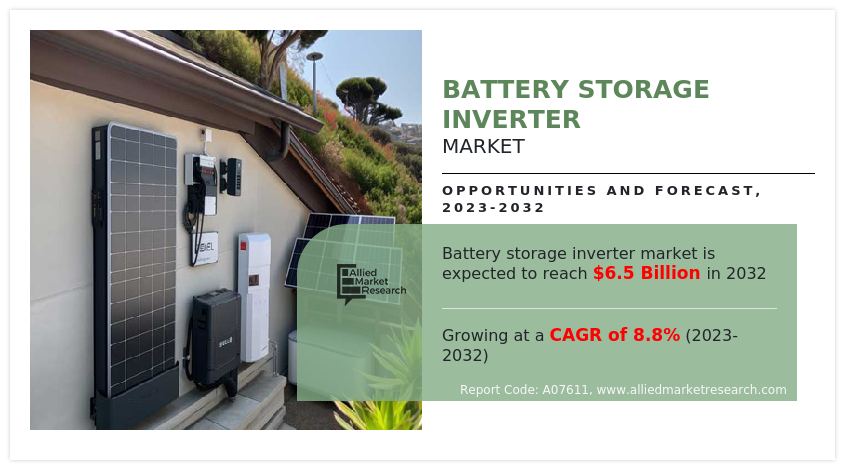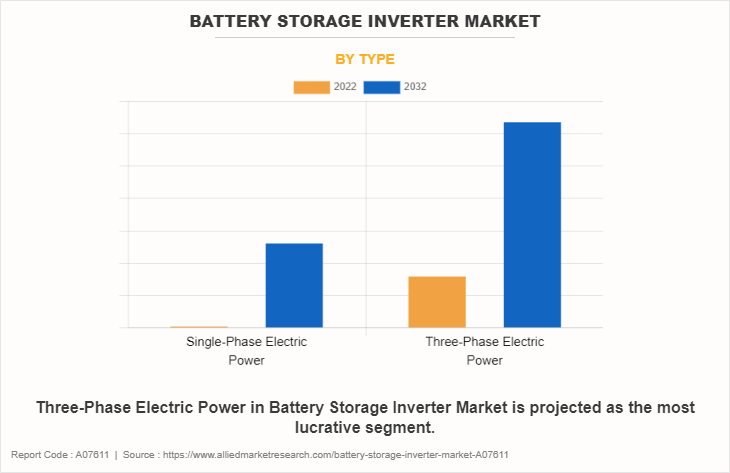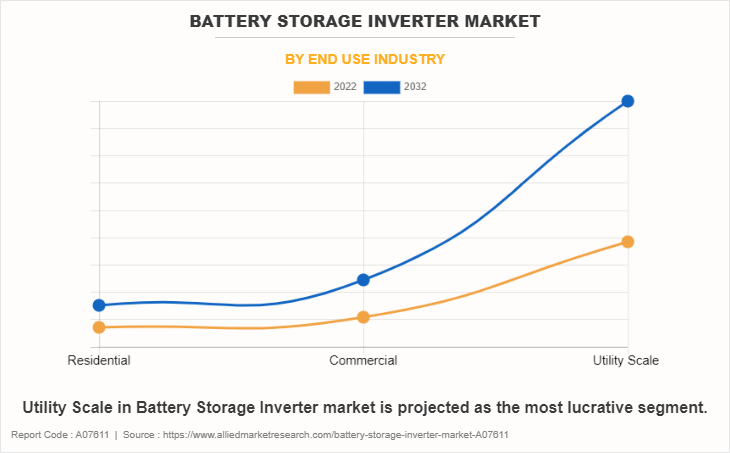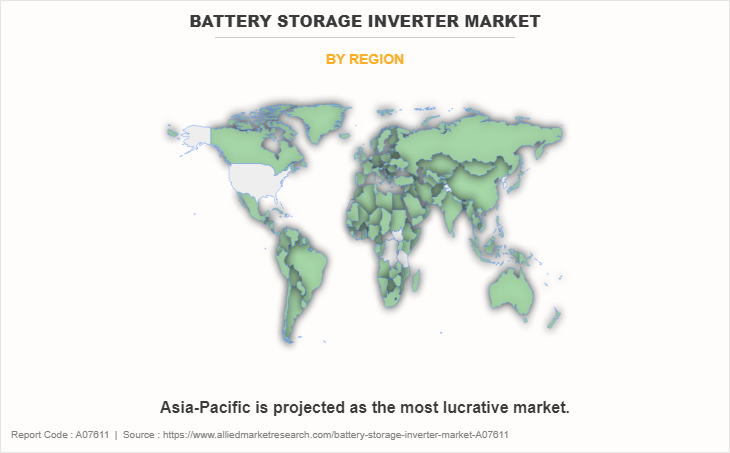Battery Storage Inverter Market Research, 2032
The global battery storage inverter market size was valued at $2.8 billion in 2022, and is projected to reach $6.5 billion by 2032, growing at a CAGR of 8.8% from 2023 to 2032.
Report Key Highlighters:
- The battery storage inverter market has been analyzed in value. The value of this market is analyzed in millions.
- Global Battery storage inverter market is fragmented in nature with many players such as KACO new energy, SMA Solar Technology AG, Sensata Technologies, Inc., Ingeteam, SolaX Power, Poweroneups, GOODWE, Eaton, SUNGROW, and Guangdong Zhicheng Champion Group Co., Ltd. Also tracked key strategies such as product launches, acquisitions, mergers, expansion etc. of various manufacturers of battery storage inverter.
- Included more than 20 countries in the report which covers market volume as well as market value for all the countries of Battery storage inverter market.
- Covered the detailed list of manufacturers by application of the battery storage inverter market. It covers the product information, application, and geographical presence of the companies.
- Conducted primary interviews with raw material suppliers, wholesalers, suppliers, and manufacturers of the Battery storage inverter market to understand the battery storage inverter market trends, growth factors, pricing, and key players competitive strategies.
- The qualitative data in this report aims at the battery storage inverter market share, and battery storage inverter market forecast.

Battery storage inverters, also known as battery inverters or hybrid inverters, are devices used in energy storage systems to convert direct current (DC) electricity from batteries into alternating current (AC) electricity, which is the type of electricity used in most electrical systems. They are an essential component of battery energy storage systems, allowing for the efficient use and integration of stored energy.
Battery storage inverters can be programmed to optimize self-consumption. This means that when solar panels are generating excess electricity, the inverter can prioritize charging the batteries or running appliances rather than exporting excess energy to the grid. Battery storage inverters manage the charging and discharging of energy storage batteries to maximize their lifespan and performance. They also prevent overcharging and over-discharging, which can damage batteries.
Many modern battery storage inverters come with data monitoring capabilities, allowing homeowners to track their energy production, consumption, and battery status through mobile apps or web interfaces. Battery storage inverters should be highly efficient to minimize energy losses during the conversion process. Look for inverters with high efficiency ratings. Battery storage inverters are a crucial component of modern energy systems, enabling homeowners and businesses to harness the benefits of energy storage and renewable energy sources like solar power. This will drive the market growth during the forecast period.
Furthermore, the residential sector has witnessed significant growth in solar photovoltaic (PV) installations. Technological advancements, economies of scale, and increased competition in the market have contributed to cost reductions. As battery storage systems become more affordable for residential customers, the adoption of battery storage inverters in homes becomes more economically viable. Homeowners are increasingly seeking energy independence and resilience against power outages.
Battery storage inverters allow homeowners to store excess solar energy and use it during grid outages, providing backup power supply to essential loads. This capability enhances energy security and peace of mind for residential customers. Battery storage inverters enable homeowners to optimize their energy usage by storing excess energy during low-demand periods and using it during high-demand or more expensive time-of-use periods. This helps reduce electricity bills and optimize the cost-effectiveness of residential solar PV systems.
The global battery storage inverter market is anticipated to register substantial growth during the forecast period due to the growing global focus on clean energy and the transition towards renewable energy sources such as solar and wind power is driving the demand for battery storage inverters. These inverters play a crucial role in storing and managing the intermittent electricity generated by renewable sources, ensuring a steady and reliable power supply. Furthermore, battery storage inverters allow individuals, businesses, and even entire communities to become more energy independent. By storing excess electricity generated during periods of low demand or high renewable energy production, users can rely on stored energy during peak demand or when the grid is unavailable or unreliable. This enhances energy resilience and can provide backup power during power outages or emergencies.
The cost of battery storage systems, including batteries and inverters, has been steadily declining in recent years. This cost reduction, driven by advancements in battery technology, economies of scale, and improved manufacturing processes, has made energy storage solutions more affordable and attractive to a broader range of customers, including residential, commercial, and utility-scale applications. However, industrial discharges or solid wastes of paint and coatings materials interfere with local sanitary sewers that lead to discharge of pollutants into local waterways. This hinders growth of the Battery Storage Inverters industry, owing to rise in environmental concerns.
The global battery storage inverter market is segmented on the basis of types, end-use industry and regions. On the basis of types, the market is segmented into single-phase electric power and three-phase electric power. On the basis of end-use industry, it is segmented into residential, commercial , utility-scale and others. On the basis of region, the market is studied across North America, Europe, Asia-Pacific, and LAMEA.
Major players operating in the global battery storage inverter market include KACO new energy, SMA Solar Technology AG, Sensata Technologies, Inc., Ingeteam, SolaX Power, Poweroneups, GOODWE, Eaton, SUNGROW, and Guangdong Zhicheng Champion Group Co., Ltd. These players have adopted product launch as their key strategy to strengthen their presence in the market.
Other players operating in the global battery storage inverter market include SolarEdge, Enphase Energy, SMA Solar Technology, ABB, Fronius, LG Chem, Schneider Electric, OutBack Power and others.

On the basis of type, the three-phase electric power segment dominated the global battery storage inverter market in 2022 and is expected to maintain its dominance during the forecast period, owing to three-phase battery storage inverters help manage the variability of these sources by storing excess energy during peak production and releasing it when demand is high or production is low. This enhances grid stability and reduces the reliance on fossil fuels.

On the basis of end-use industry, the utility-scale segment dominated the global battery storage inverter market, in terms of revenue, in 2022, owing to battery storage inverters play a crucial role in enhancing grid stability and reliability. They provide fast response times to changes in demand and supply, helping to balance the grid and mitigate fluctuations caused by the integration of renewable energy sources.

On the basis of region, the Asia-Pacific region dominated the global battery storage inverter market, in terms of revenue, in 2022, due to many countries in the Asia-Pacific region have ambitious renewable energy targets to reduce greenhouse gas emissions and enhance energy security. Battery storage inverters play a vital role in integrating intermittent renewable sources like solar and wind into the grid.
Key Benefits For Stakeholders
- This report provides a quantitative analysis of the market segments, current trends, estimations, and dynamics of the battery storage inverter market analysis from 2022 to 2032 to identify the prevailing battery storage inverter market opportunities.
- The market research is offered along with information related to key drivers, restraints, and opportunities.
- Porter's five forces analysis highlights the potency of buyers and suppliers to enable stakeholders make profit-oriented business decisions and strengthen their supplier-buyer network.
- In-depth analysis of the battery storage inverter market segmentation assists to determine the prevailing market opportunities.
- Major countries in each region are mapped according to their revenue contribution to the global market.
- Market player positioning facilitates benchmarking and provides a clear understanding of the present position of the market players.
- The report includes the analysis of the regional as well as global battery storage inverter market trends, key players, market segments, application areas, battery storage inverter market analysis, and market growth strategies.
Battery Storage Inverter Market Report Highlights
| Aspects | Details |
| Market Size By 2032 | USD 6.5 billion |
| Growth Rate | CAGR of 8.8% |
| Forecast period | 2022 - 2032 |
| Report Pages | 221 |
| By Type |
|
| By End Use Industry |
|
| By Region |
|
| Key Market Players | KACO new energy, SMA Solar Technology AG, SUNGROW, Ingeteam, Eaton, Guangdong Zhicheng Champion Group Co., Ltd., Sensata Technologies, Inc., SolaX Power, GOODWE, Poweroneups |
Analyst Review
According to the opinions of various CXOs of leading companies, growth in demand from residential, commercial, and utility majorly drives the market. There are several factors driving the growth of the battery storage inverter market. One of the main drivers is the increasing deployment of renewable energy sources such as solar and wind power. As the penetration of renewable energy increases, the need for energy storage solutions becomes more important to balance supply and demand and manage intermittent generation.
Furthermore, in residential settings, battery storage systems paired with solar panels allow homeowners to store excess energy generated during the day and use it during peak demand periods or when the sun is not shining. In commercial and utility-scale projects, battery storage inverters provide grid stabilization services, backup power, and load shifting capabilities.
Growth in demand from residential, commercial, and utility majorly drives the Battery Storage Inverter Market.
Utility-scale is the leading end-use industry of Battery Storage Inverter Market.
Asia-Pacific is the largest regional market for Battery Storage inverters.
The Battery Storage Inverter Market was valued for $2.8 billion in 2022 and is estimated to reach $6.5 billion by 2032, exhibiting a CAGR of 8.8% from 2023 to 2032.
Major players operating in the global Battery Storage Inverters market include KACO new energy, SMA Solar Technology AG, Sensata Technologies, Inc., Ingeteam, SolaX Power, Poweroneups, GOODWE, Eaton, SUNGROW, and Guangdong Zhicheng Champion Group Co., Ltd.
Loading Table Of Content...
Loading Research Methodology...



